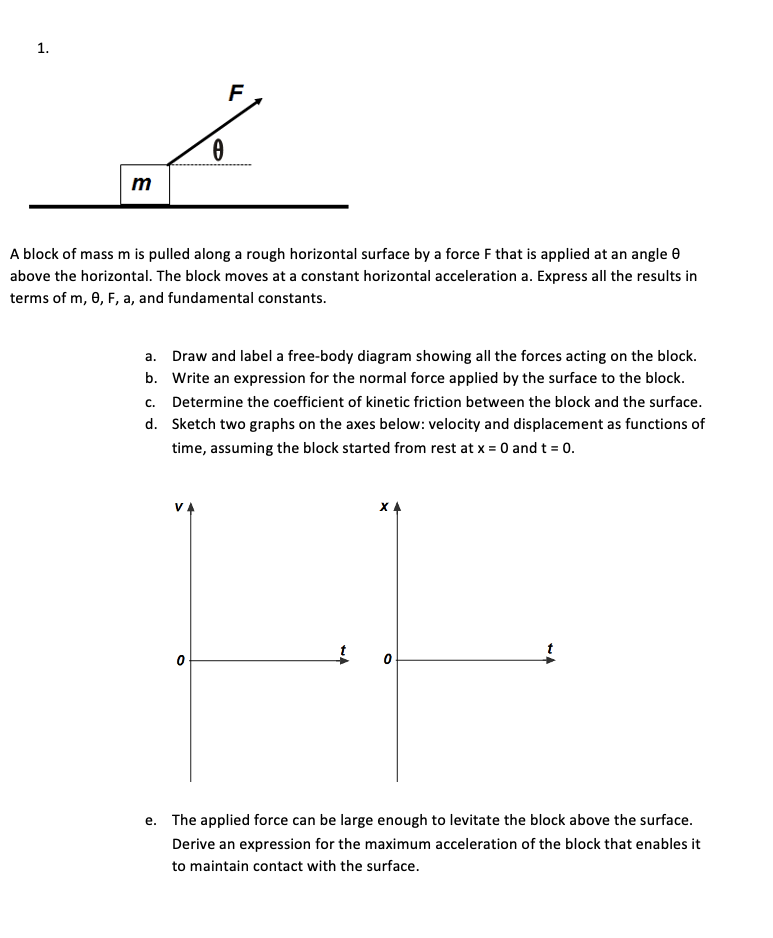F m A block of mass m is pulled along a rough horizontal surface by a force F that is applied at an angle e above the horizontal. The block moves at a constant horizontal acceleration a. Express all the results in terms of m, 0, F, a, and fundamental constants. a. Draw and label a free-body diagram showing all the forces acting on the block. b. Write an expression for the normal force applied by the surface to the block. c. Determine the coefficient of kinetic friction between the block and the surface.
F m A block of mass m is pulled along a rough horizontal surface by a force F that is applied at an angle e above the horizontal. The block moves at a constant horizontal acceleration a. Express all the results in terms of m, 0, F, a, and fundamental constants. a. Draw and label a free-body diagram showing all the forces acting on the block. b. Write an expression for the normal force applied by the surface to the block. c. Determine the coefficient of kinetic friction between the block and the surface.
College Physics
10th Edition
ISBN:9781285737027
Author:Raymond A. Serway, Chris Vuille
Publisher:Raymond A. Serway, Chris Vuille
Chapter4: The Laws Of Motion
Section: Chapter Questions
Problem 84AP: In Figure P1.84, the pulleys and the cord are light, all surfaces are frictionless, and the cord...
Related questions
Question

Transcribed Image Text:F
m
A block of mass m is pulled along a rough horizontal surface by a force F that is applied at an angle e
above the horizontal. The block moves at a constant horizontal acceleration a. Express all the results in
terms of m, 0, F, a, and fundamental constants.
a. Draw and label a free-body diagram showing all the forces acting on the block.
b. Write an expression for the normal force applied by the surface to the block.
c. Determine the coefficient of kinetic friction between the block and the surface.
d. Sketch two graphs on the axes below: velocity and displacement as functions of
time, assuming the block started from rest at x = 0 and t = 0.
e. The applied force can be large enough to levitate the block above the surface.
Derive an expression for the maximum acceleration of the block that enables it
to maintain contact with the surface.
1.
Expert Solution
This question has been solved!
Explore an expertly crafted, step-by-step solution for a thorough understanding of key concepts.
Step by step
Solved in 2 steps with 2 images

Knowledge Booster
Learn more about
Need a deep-dive on the concept behind this application? Look no further. Learn more about this topic, physics and related others by exploring similar questions and additional content below.Recommended textbooks for you

College Physics
Physics
ISBN:
9781285737027
Author:
Raymond A. Serway, Chris Vuille
Publisher:
Cengage Learning

University Physics Volume 1
Physics
ISBN:
9781938168277
Author:
William Moebs, Samuel J. Ling, Jeff Sanny
Publisher:
OpenStax - Rice University

Glencoe Physics: Principles and Problems, Student…
Physics
ISBN:
9780078807213
Author:
Paul W. Zitzewitz
Publisher:
Glencoe/McGraw-Hill

College Physics
Physics
ISBN:
9781285737027
Author:
Raymond A. Serway, Chris Vuille
Publisher:
Cengage Learning

University Physics Volume 1
Physics
ISBN:
9781938168277
Author:
William Moebs, Samuel J. Ling, Jeff Sanny
Publisher:
OpenStax - Rice University

Glencoe Physics: Principles and Problems, Student…
Physics
ISBN:
9780078807213
Author:
Paul W. Zitzewitz
Publisher:
Glencoe/McGraw-Hill

College Physics
Physics
ISBN:
9781938168000
Author:
Paul Peter Urone, Roger Hinrichs
Publisher:
OpenStax College